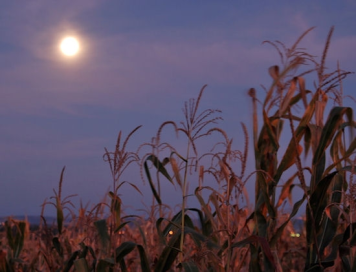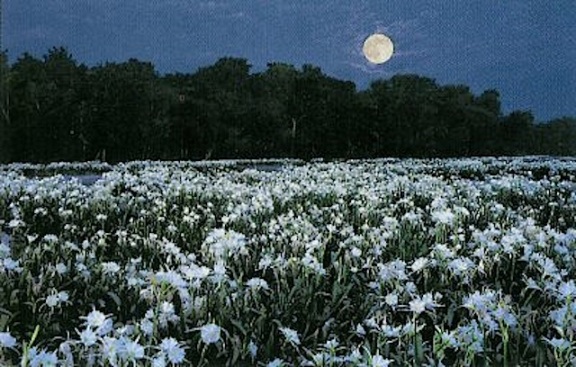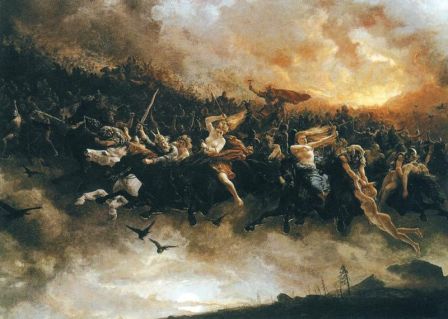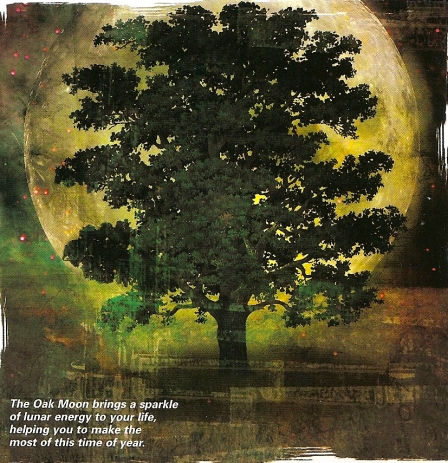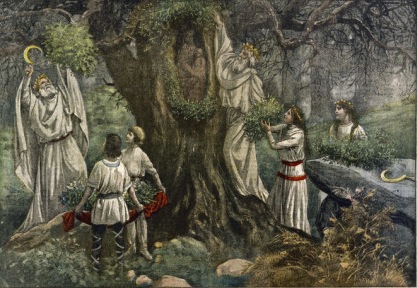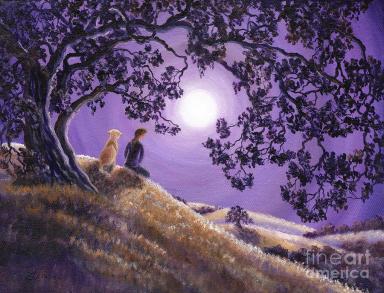
“Artemis, Goddess of the Hunt” by violscraper
“Diana’s themes are fertility, children, providence, abundance and harvest. Her symbols are the moon, water, forest items and the sun. This Roman Goddess embodies the moon’s fertility and watery aspects along with the sun’s protective and nurtuirng power over the forests and its creatures. On this day she was celebrated in Rome and She will be remembered in our hearts as the huntress who helps us capture the spiritual ‘food’ we need.
Starting on August 13, the Romans had a weeklong festival for Diana, praying to Her for the harvest’s bounty and to turn damaging storms away. The traditional place to leave an offering of fruit or vines for Her is in the forest, or at a crossroads. As you do, if any stone or leaf catches your eye, pick it up and carry it as a charm that will keep Diana’s power with you that entire day. Come night, release the gift to flowing water or back to the earth with a prayer of thanks and a wish for one of Diana’s atttributes that you wish to develop in your life.
It is also customary to light some fire source to honor Her on August 15 or anytime during the festivities. Afterward, to generate this Goddess’s physical or figurative fertility within you, follow Roman convention and wash your hair with specially prepared water (water to which a little milk is added so that it looks white, like the moon). If you have children, doing this for them incurs Diana’s protection over their lives.”
(Patricia Telesco, “365 Goddess: a daily guide to the magic and inspiration of the goddess”.)

“Artemis” by Howard David Johnson
Patricia Monaghan tells us that “today we confuse Diana with the Greek Artemis, seeing both in the familiar picture of the lightly clad, bow-bearing Goddess who rides the moon or strides through the forest with Her nymphs. And in later Roman times, Diana was indeed so pictured, but only after the original Italian Goddess was assimilated into the powerful figure of Artemis, the Goddess of the conquered Greeks.

“Moon Goddess” by Josephine Wall
Diana was originally queen of the open sky, worshiped only outdoors, where Her domain stretched overhead. Possibly She was ruler of the sun as well as the moon, for the early Italians had no sun god and had to adopt Apollo for that role. Diana’s name comes from the word for ‘light’; probably She was the original Italian ruler of the sun.
She ruled on earth as well, as bestower of sovereignty and granter of conception; thus She was sometimes called the threefold Diana Trivia. With two other deities She made up another trinity: Egeria the water nymph [one of the Camenae], Her servant and assistant midwife; and Virbius, the mysterious woodland god. The three lived together in the famous Wood of Nemi near Aricia, where runaway slaves competed for mistletoe – the Golden Bough that would give them a fighting chance for the position of Diana’s priest. Not a job a modern man would covet, the priesthood meant continual vigilance against the next contender for the post, and ultimately death at a successful rival’s hand.

“Diana” by Lotta-Lotos
This fatal kingship was one of the few roles men could play in worship of Diana. Otherwise, the sky queen was entirely a woman’s Goddess. On Her feast day, August 15 – today the Catholic feast day of Mary’s assumption into heaven – processions of women would journey to Aricia to offer thanks in Diana’s grove for Her help that year and to implore Her continuing aid. The hunting dogs who accompanied them were crowned but kept leased so as not to disturb the wild creatures who lived under Diana’s sky. Eventually Diana worship moved closer to the population center, to the Aventine Hill in Rome itself, where women continued to flock to Her shrine for ritual hair-washing and invocations for aid in childbed” (p. 103 – 104).
Thalia Took tells us that “the Romans recognized three aspects of Her–as the Moon-Goddess, they called Her Luna; as an underworld deity of magic, Hekate; and as the huntress-Goddess, Diana.”

“Mother Nature” by Rozairo
Interestingly enough, Thalia Took also tells us that “in Gaul, She was identified with Nemetona, ‘Goddess of the Sacred Grove’, and considered the consort of Mars“. This makes sense, as Diana Nemorensis (“of the Grove”) had Her temple in a forest on the Lake Nemi‘s shores and was the Goddess of wild places who loved forests. [1]

“Diana” by Maltshakes
ASSOCIATIONS: (Goddess symbols of Artemis, but I would think would be appropriate for Diana as well)
General: Crescent moon (new moon), bow and arrow, sandals, clouds, three pillars, and blue sky.
Animals: Dogs, guinea fowl, elephant, horses, bear, dove, deer, and bee.
Plants: Anemones, flowering almond, hazel, ranunculus, honeysuckle, thistle, laurel, and fir tree.
Perfumes/Scents: Jasmine, aloe, ginseng, lemon verbena, and camphor.
Gems and Minerals: Moonstone, pearl, quartz, crystal, silver, turquoise, iron, aluminum, and diamonds.
Colors: Silver, white, red, green, and turquoise. [2]
Sources:
Goddessgift.com, “Symbols of Artemis”.
Monaghan, Patricia. The New Book of Goddesses and Heroines, “Diana”.
Took, Thalia. A-Muse-ing Grace Gallery, “Diana“.
Suggested Links:
Covenofthegoddess.com, “Goddess Diana“.
Encyclopedia.com, “Diana“.
Fischer-Hansen & Birte Poulsen. From Artemis to Diana: The Goddess of Man and Beast (Acta Hyperborea).
Goddess-guide.com, “The Roman Goddess Diana“.
GrayWolf, Danu. Order of the White Moon, “Diana“.
Greek-gods-and-goddesses.com, “The Roman Goddess Diana“.
Grimassi, Raven. Encyclopedia of Wicca & Witchcraft, “Lady of the Lake” & “Lake Nemi”
Journal of a Poet, “Artemis/Diana, Goddess of the Moon“.
Leland, Charles Godfrey. Aradia: The Gospel of the Witches.
Monaghan, Patricia. Matrifocus.com, “Trivia: Goddess of the Crossroads“.
Revel, Anita. igoddess.com, “Artemis: out with the old – peaceful warrior“.
Revel, Anita. igoddess.com, “Diana: go wild!“.
Roman-colosseum.info, “Myths about the Roman Goddess Diana“.
Richardson, Adele & Laurel Bowman. Diana.
Tate, Karen. Sacred Places of Goddess: 108 Destinations.
Thewhitegoddess.co.uk, “Diana – Goddess of the Hunt“.
Wikipedia, “Diana (mythology)“.
Wikipedia, “Diana Nemorensis“.
Wikipedia, “Rex Nemorensis“.
V. Goddessschool.com, “Diana ‘Queen of Heaven’“.




